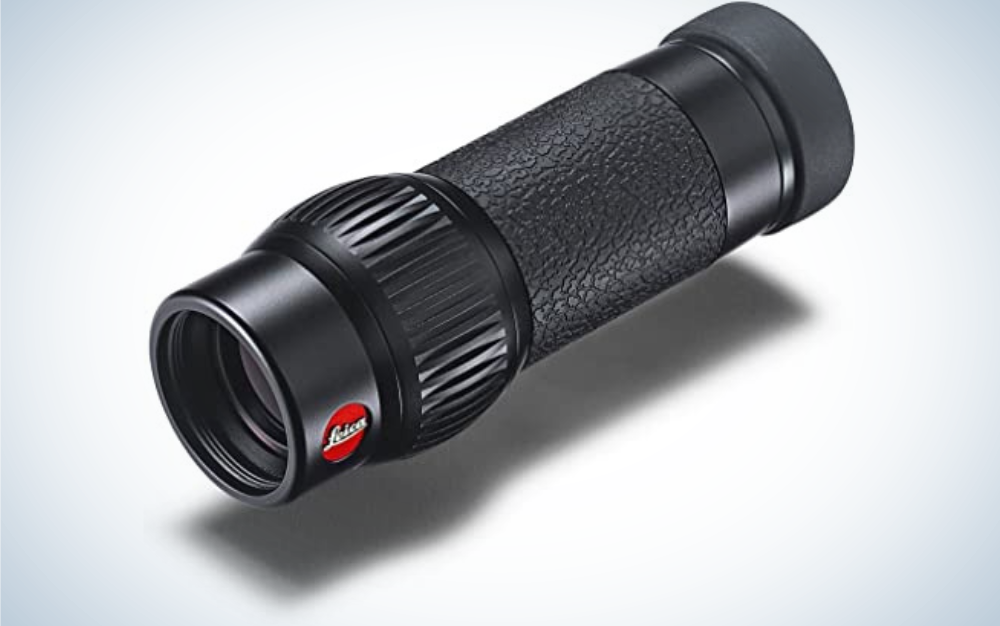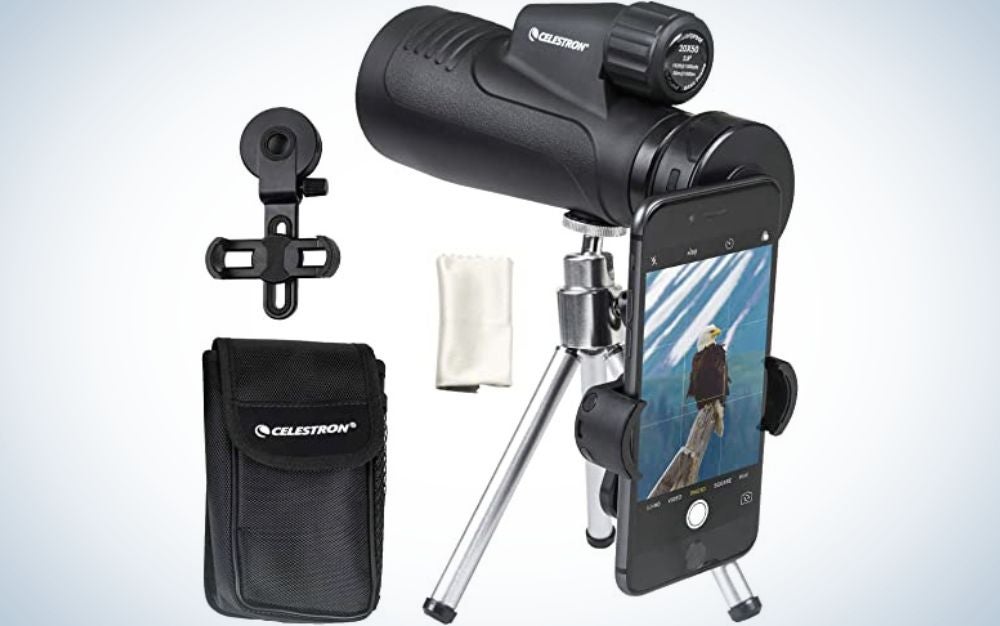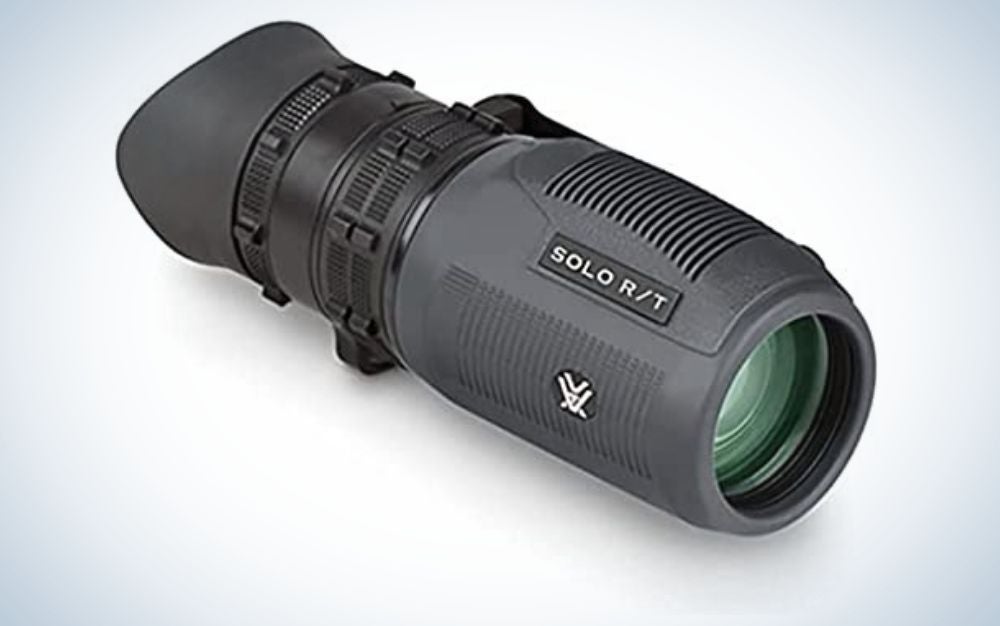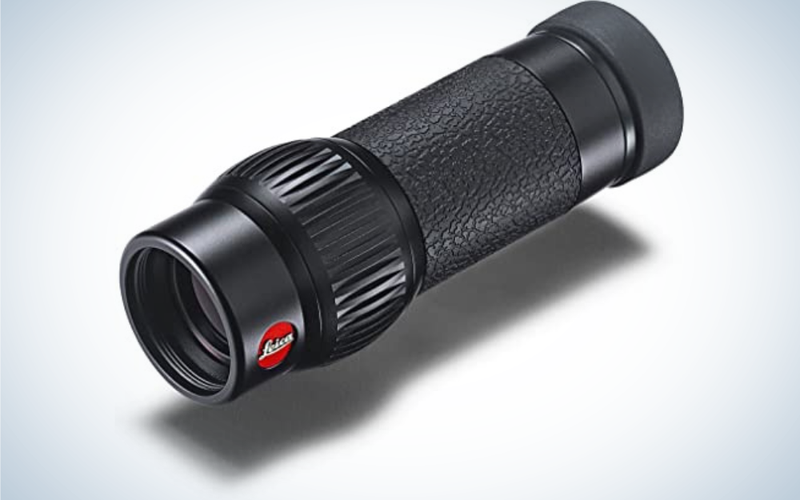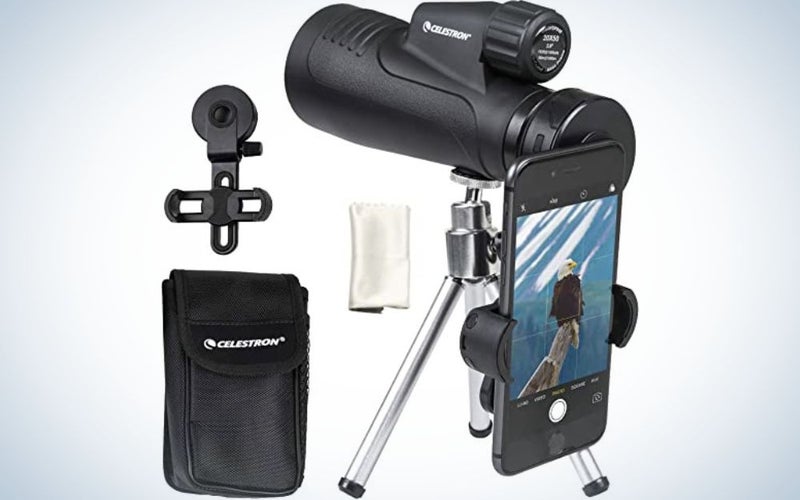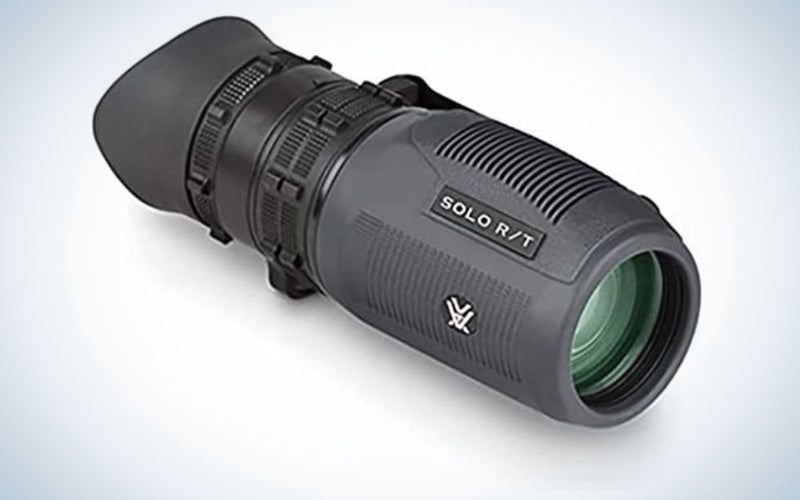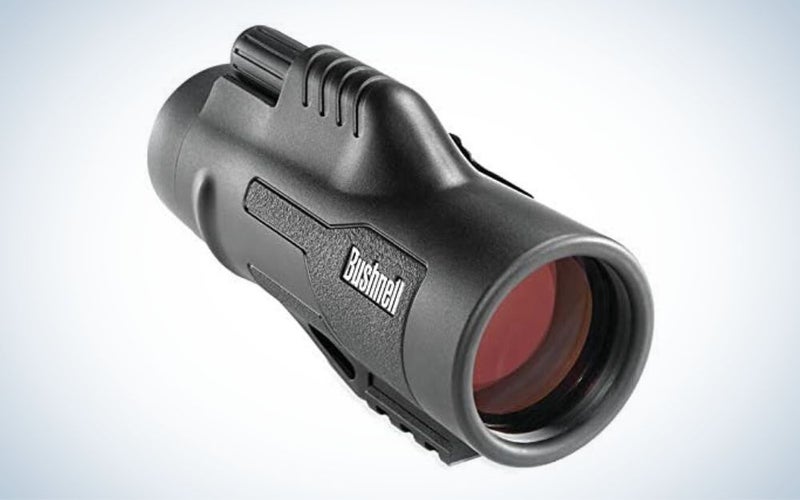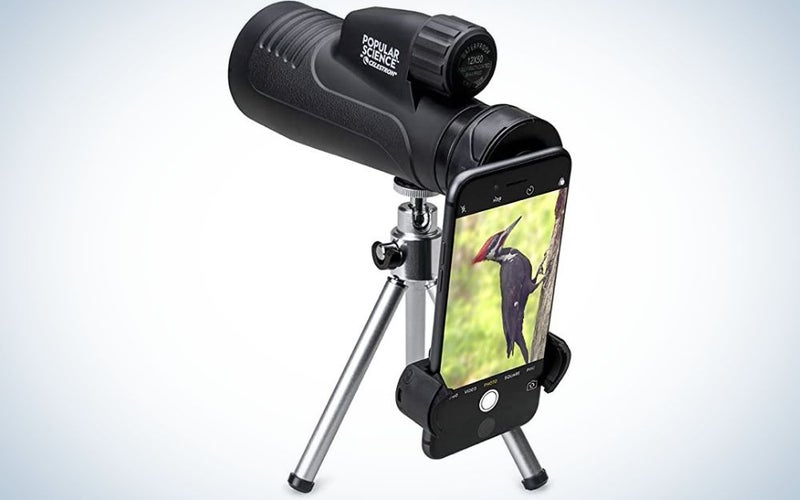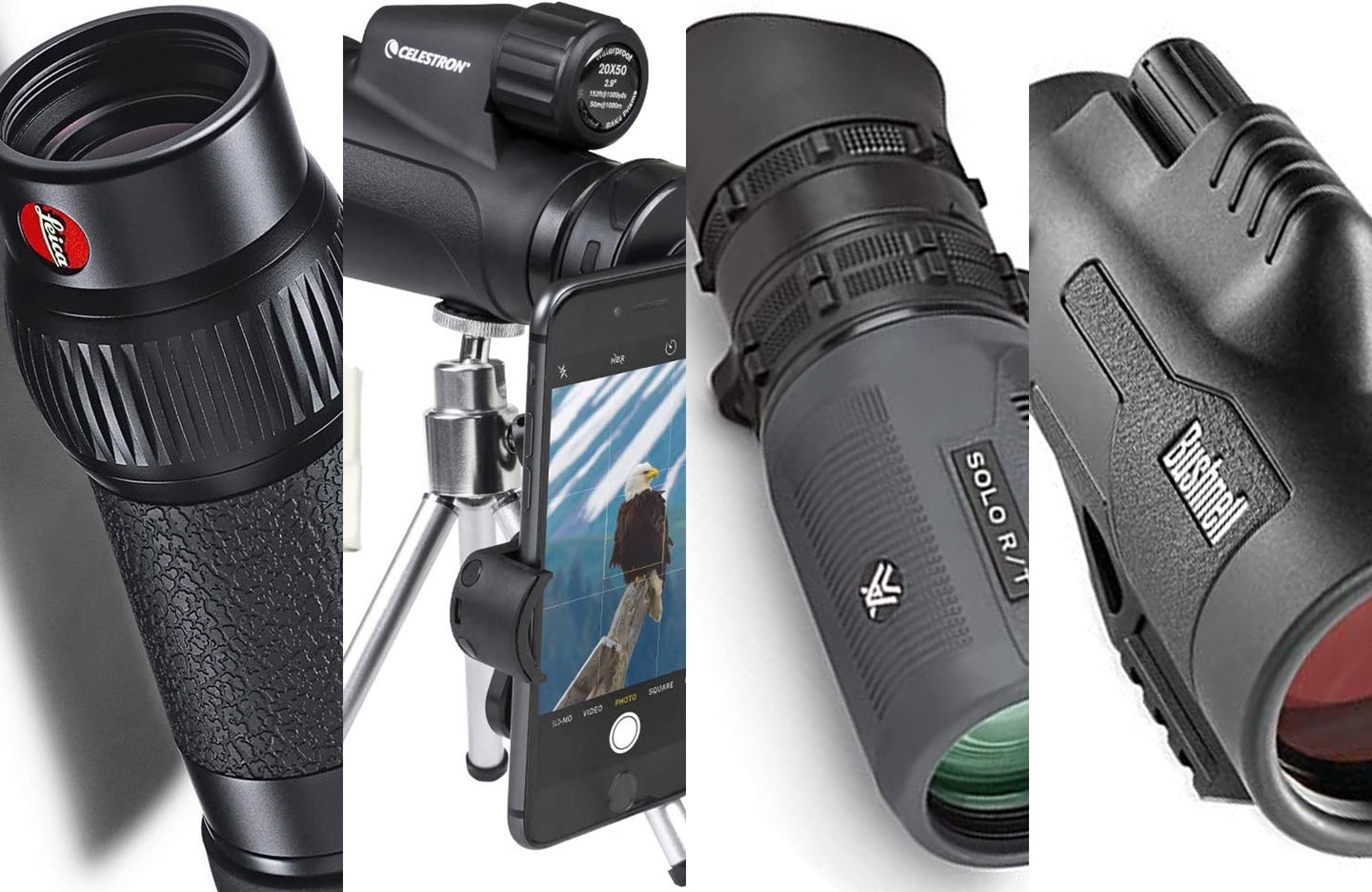
We may earn revenue from the products available on this page and participate in affiliate programs. Learn more ›
When looking for the best option in field optics, there are many reasons why someone would choose a monocular over binoculars as their go-to piece of glass. In this guide, we reviewed several monoculars and put forth our picks for the best monoculars.
While every monocular is suitable for most tasks, some are better suited for a particular use. For instance, a monocular with a higher twilight coefficient will be best for stargazing. On the other hand, a monocular with higher magnification will command its place as the best for hunting. No matter what your needs, the best monoculars will be up for the task
- Best overall: Leica Monovid 8×20
- Best for stargazing: Celestron Outland X 20×50
- Best for hunting: Vortex Solo RT 8×36
- Best for bird watching: Bushnell Legend Ultra 10×42
- Best for cell phones: Celestron Outland X 12×50
Methodology: How we picked the best monoculars
Throughout our review process, the physical features we evaluated include image definition, build quality, magnification power, and light coefficients to determine the best monoculars. In addition to those qualities, we also took into account the various environments and tasks each tool would be used to help you determine which monocular is right for you. Perhaps one of our favorite tests in this entire article of monocular reviews was where we took our monoculars out to the field to shoot the night sky with our cellphones.
With many available options for monoculars, it can be difficult to determine which optics are the best choice to build quality. For this reason, we covered reputable manufacturers with a proven track record of offering high-quality monoculars. So the next time you find yourself in the market for a monocular for hunting, birding, star gazing, or even taking pictures with your cell phone, this article can be your guide for selecting the most powerful monocular.
Best monoculars: Reviews & Recommendations
Best overall: Leica Monovid 8×20
Leica
Why it made the cut: When it comes down to sheer versatility, the Leica Monovid 8×20 stood out in a class of its own. It’s also waterproof and is one of the smallest and lightest on the market.
Key features:
- Magnification: 8x
- Field of View: 6.3 degrees
- Twilight Coefficient: 12.6
- Weight: 4 ounces
Pros
- Works well for a variety of activities
- Lightweight and compact
- Includes a macro lens attachment
- Durable build
Cons
- Pricey
The Leica Monovid is a tiny monocular, measuring only 1.4 x 3.85 x 1.4 inches. However, even with its slim form factor, this little tool doesn’t skimp on any of the features it provides. With a magnification of 8x, this monocular is very well suited for everyday use for general magnification. Other monoculars you will come across on this list are specialized in what purpose they serve, which makes them great in those categories but provide a less-than-desirable experience in other situations. It also comes with a macro lens attachment, making it even more versatile.
Coming in at a staggering 4 ounces, carrying this monocular all day long will be no problem at all. In fact, you might even forget it’s even there. The fact that you can have such superb image quality in such a small package is outstanding.
The only drawback we had with this monocular is the same heartbreak we experience time and time again as photographers. As with all things Leica, the Monovid carries a price tag in line with the brand’s reputation, which may price out anyone looking for a more budget-friendly solution. But, it is waterproof to 16.5 feet and fog proof, making it a durable piece of equipment that will last.
Best for stargazing: Celestron Outland X 20×50
Celestron
Why it made the cut: It has a high twilight coefficient and magnification, helping pick up light from even the most distant celestial bodies, making it an excellent choice for stargazing.
Key features:
- Magnification: 20x
- Field of View: 2.9 degrees
- Twilight Coefficient: 31.6
- Weight: 15 ounces
Pros
- High twilight coefficient
- Tripod included
- Includes a cell phone mount
- High magnification level
Cons
- Bulky
Whether it’s camera lenses, binoculars, telescopes, or monoculars, big glass usually means one thing, the ability to bring in lots of light. We are glad to report that the same assumption holds true here. If a twilight coefficient of 20 is considered average, then the Celestron Outland X is the heavyweight, coming in at an astounding 31.6. With a twilight coefficient that high, this monocular produces spectacular images of whichever subject in the night sky you decide to point it at.
As if that wasn’t enough, Celestron sweetens the package by including a few accessories with your purchase. While certainly not the best quality, the included tripod and cell phone mount opens up a whole playground of possibilities right out of the box. So once you’ve had fun panning across the sky, challenge yourself to take photos of those stars and planets with ease by attaching this mini telescope to your cell phone’s camera.
There is a price to pay for all of this glass, though. No, not the price that comes out of your pocket. With a large objective lens, this monocular is one of the largest on the market. It measures 7.5 x 4.6 x 3.5 inches and weighs almost a pound. So, if size is important in your purchasing decision, you may want to think twice when picking this one up. But, if the size is no issue, then the Celestron Outland X 20×50 brings worlds of discovery possibilities to your hands. Pun fully intended.
Best for hunting: Vortex Solo RT 8×36
Vortex
Why it made the cut: When it comes to hunting, lightweight and feature-rich equipment are key factors in standing out amongst the competition. The Vortex Solo RT 8×36 was specifically built with this purpose in mind.
Key features:
- Magnification: 8x
- Field of View: 7.5 degrees
- Twilight Coefficient: 17
- Weight: 10.2 ounces
Pros
- Lightweight
- Rangefinder Capabilities
- Rugged Build
Cons
- Magnification could be higher
Hunting is an activity that requires hunters to carry an extensive array of gear for a day in the field. Ask any hunter to dump their pack on the ground, and the amount of gear that will come out would surprise you. That’s why anyone serious about hunting seeks out equipment that is lightweight and built like a tank. At only 10.2 ounces, the Vortex Solo RT is a small, lightweight tool that will easily find a home in any hunter’s day pack.
As a bonus, Vortex managed to build a basic rangefinder reticle in the sight picture of this monocular. While minuscule to some, this feature is a massive addition for hunters actively chasing game over long distances. Glassing sessions will be much more efficient as a result.
It seems as if Vortex took every small detail into account in the design of this monocular. For example, even the eyecup is specially formed to surround the eye socket to block out the midday sun, allowing users to focus on glassing instead of fighting intrusive light.
While a magnification of 8x is perfect for general use, we do wish the RT series of the Solo line had an offering with a higher magnification power. It likely isn’t a big deal for most users, but the option to bump up in power would be nice since you can have this monocular at such an affordable price.
Best for bird watching: Bushnell Legend Ultra HD 10×42
Bushnell
Why it made the cut: Mid-range magnification, a large objective lens, and a clear image provide an enjoyable birdwatching experience with this monocular.
Key features:
- Magnification: 10x
- Field of View: 6.5 degrees
- Twilight Coefficient: 20.5
- Weight: 13.2 ounces
Pros
- Excellent image quality
- Has an attached, convenient carrying clip
- Compatible with tripod use
Cons
- Lens cap can be loud
Bird watching is a fun, leisurely sport enjoyed by many. And similarly to their subjects, bird watchers have a wide list of expectations from their equipment. So whether you are an enthusiast who enjoys bird watching while hiking or an enthusiast who plans their day around bird watching, this monocular has something for you.
Firstly, a bright clear image is paramount when observing our feathered friends. With an objective element of 42mm, this monocular has no problem producing a bright and clear image. It’s not the lightest monocular on this list. But it is very impressive that Bushnell was capable of putting that much glass into the Legend Ultra HD and keeping it relatively slim.
If birdwatching is a secondary activity while enjoying the outdoors, then the attached carry clip is an excellent addition. It allows you to keep your monocular close at hand for when you are ready to use it. Or, if your bird watching requires you are stationary for longer periods, Bushnell built in a tripod mount for the option of added stability.
With any activity involving observing wildlife, stealth is a crucial requirement for success. This is where the biggest gripe we have with Bushnell comes into play. The Legend Ultra HD comes with a plastic lens cover, which is not a big deal with any other activity. However, when trying to be as quiet as possible, any false move with this lens cap, and you’ll have quite the racket on your hands.
Best for cell phones: Celestron Outland X 12×50
POPULAR SCIENCE
Why it made the cut: Monoculars have become a popular tool for taking photos at distance with cell phones. Celestron developed the Outland X 12×50 with an accessory package specifically for such use, earning its spot as the best monocular for cell phones.
Key features
- Magnification: 12x
- Field of View: 4.7
- Twilight Coefficient: 24.5
- Weight: 14.8 ounces
Pros
- Comes with a cell phone accessory package
- Affordable price
- Bright image helps phone imaging sensors
Cons
- Eye caps are easy to lose
Cell phone cameras have come a long way since the days of flip phones and T9 predictive texting. These imaging powerhouses have opened a plethora of opportunities for taking pictures, allowing the everyday user to capture life’s moments easily. And people haven’t stopped pushing the envelope of what’s possible, which is how monoculars have seen a resurgence in the market. Cellphone users have discovered that pairing their phones with a quality monocular provides new possibilities without sacrificing image quality.
Celestron saw this trend and provided a product specifically for smartphone users in their Outland X 12×50 package. Outside of the exceptional monocular, the phone accessories included with it ensure that anyone purchasing this product will have everything they need right out of the box. A tripod, a Bluetooth remote for hands-free operation, and a cellphone mount that puts your phone’s camera in line with the viewing element give you all the tools you need to start taking telephoto images with your phone immediately.
The best part is that this whole package is still at a very affordable price. Even with such a fantastic price point, Celestron didn’t overlook features important to cell phone users. With their tiny sensors, cell phones are notorious for needing lots of light to take a decent picture. Celestron put the same 50mm objective element on every Outland X series of monocular, which is wide enough to flood your phone’s camera with all the light it needs.
If you purchase this monocular, we do hope that you don’t share one of the same qualities that plague several of us here at PopPhoto. If so, we recommend storing your lens caps in the provided storage case or purchasing a lanyard. If there were a tally for every time one of us had to buy a replacement lens cap, we would need a new whiteboard. Unfortunately, a lanyard that attaches the lens cap to the monocular was not included. However, if you buy one separately, there is a small rubber loop for this feature to prevent losing your lens cap.
Things to consider when purchasing the best monocular
Magnification
If you are bird-watching, hunting, or stargazing, magnification plays a huge role in determining which optic is best for you. While higher magnification means you can get a closer view of your subject, finding the right balance of usability and magnification is crucial to having an enjoyable experience.
The higher your magnification level, the harder it becomes to handhold. This is because at higher magnifications, every vibration, whether it be wind or even vibration from shaky hands, is multiplied at the same strength. A magnification of 8x or 10x is recommended for starting with handheld monoculars. But with good stabilization techniques, 12x or even 15x can be completely usable. And, you can always get a tripod to mount your monocular to for more stability.
Twilight Coefficient
Put simply, the twilight coefficient tells you how well a monocular will perform in low light conditions. A higher twilight coefficient means the monocular can pick up more light, allowing you to see more detail in low light.
To determine the twilight coefficient, multiply the lens magnification by the size of the objective lens (in mm) and then calculate the square root of that result. This number doesn’t take factors such as lens coatings into account, which can alter the transmission of light, but it is a good starting point to determine how much detail you’ll be able to pick up with minimal light.
Field of view
There are two ways that manufacturers measure and refer to field of view. In this article, we will be using the angular field of view. Angular field of view means that out of the full 360 degrees, your angular field of view is the area you will be able to see through the lenses.
The other field of view measurement is based on the distance visible at 1000 yards or meters. For example, you may see a field of view stated as 450 feet at 1000 yards. This measurement tells you that at 1000 yards, you can expect to see 450 feet across.
Waterproofing
Different environments will require different levels of weatherproofing. For example, if you plan on bringing your monoculars on boating adventures, you’ll want full waterproofing just in case they fall overboard, or you’re dealing with crashing waves. But, if you are in a desert environment, waterproofing may not matter as much.
Another feature to look for is fog proofing. Humidity levels can change significantly at dawn, dusk, and overnight, so if you are out during those times, having a pair that can resist fogging up will be helpful.
Weight
In instances where every piece of gear must adhere to strict weight restrictions, many users will opt for a good monocular. For example, some hunting trips can take you well into the backcountry, and lugging around a heavy pair of binoculars could mean going over your ideal weight leading to neck and back pain over extended treks. For this reason alone, purchasing a good monocular can reduce the overall weight of your field optics by half, saving you valuable space and weight.
FAQs
Q: What is the highest-rated monocular?
The highest-rated monocular on our list is the Vortex Optics Solo R/T 8×36 Monocular. It not only has a very high rating from customers but has the most reviews of the monoculars we looked at.
Q: What is the strongest magnification for monoculars?
Several monoculars claim they are 40×60-powered monoculars. However, these are more in line with smaller spotting scopes. As far as traditional monoculars, Osprey Global & Konus (not covered in this article) both make an 8-24x variable magnification monocular that could be considered the strongest magnification monocular. For fixed magnification monoculars, Celestron ranks amongst the highest magnification with their Outland X 20×50 monocular.
Q: What is the best monocular for distance?
The best monocular for distance is going to be one with high magnification. The most powerful monocular we reviewed is the Celestron 20×50 monocular. 20x magnification will allow you to see longer distances, but it is at the cost of increased image vibration.
Q: What is a good brand of monocular?
Many great reputable manufacturers produce monoculars. Depending on your monocular needs, the best monocular manufacturer may vary for you. The brands listed in this buying guide are all reputable manufacturers that consistently produce high-quality optics. So whether you go with Leica, Celestron, or Vortex, you’ll be getting a solid monocular.
Q: Can you see the moon with a monocular?
While you can certainly see the moon with any monocular, a few are better suited for the task. With the highest twilight coefficient available on the market, the Outland X from Celestron is one of the most powerful monoculars suited for stargazing at any magnification.
Q: Are monoculars good for stargazing?
Yes, monoculars are good for stargazing. They are a popular tool for amateur and professional astronomers alike. With their small form factor and portability, monoculars allow astronomers to stargaze at their leisure without the hassle of setting up more complex optics. And with their lower price point and broader uses, monoculars are also a fantastic entry point for getting out in the field and observing your first experiences looking at the night sky.
Q: How much do monoculars cost?
How much monoculars cost depends on the particular monocular and its features. But, generally speaking, one of the best aspects of monoculars is their affordable price point. Monoculars are often less than 50% of the cost of a decent pair of binoculars. On the lower end of the scale, you can pick up a monocular for around $20 for the budget-conscious buyer. For a premium monocular, expect to pay up to $1500 for your optic. However, on average, for a high-quality monocular that won’t break the bank, a median price point of $100-$300 will net you an excellent monocular that will last you for years to come.
Final thoughts on monoculars
After reviewing several brands, models, and styles of monoculars, these were our top-rated monoculars. Even though how you use your monocular will somewhat determine how it performs, we are confident that you will find an optic perfect for your needs in our monocular reviews.
The post Best monoculars in 2022 appeared first on Popular Photography.
